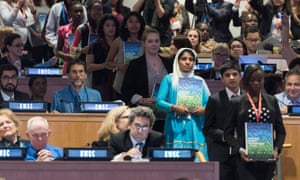
In the News
Leaders pledge $25bn to improve health of women, children and adolescents
-
Focus Areas
Global Health, Women, Youth & Children -
Expertise
Leadership Development -
Programs
Rise Up
Adolescents join women and children for first time in updated global plan that aims to reduce preventable deaths and transform outlooks for SDG generation

Poor-quality education, the daily threat of violence and discrimination hold back adolescent girls, and world leaders need to take action to change the landscape for young women and men, UN member states were told at the weekend.
“All Guatemalan girls and girls around the world are asking you to help us improve the world for all adolescents and girls … [They] are not only the future of the world, but also the present,” Jimena, 12, from Let Girls Lead in Guatemala, told delegates at the launch on 26 September of the revised global strategy for women’s, children’s and adolescent health.
The strategy offers a roadmap for countries to meet the sustainable development goals by 2030, particularly goal three, which calls for governments to ensure healthy lives and promote wellbeing for all.
Governments have pledged more than $25bn over the next five years to improve the health of women, children and adolescents.
The strategy builds on one launched in 2010, which spawned the Every Woman Every Child movement to mobilise resources and accelerate efforts by governments, multilateral organisations, civil society and the private sector to address the major health challenges facing women and children.
This new strategy explicitly states the importance of addressing the needs of adolescents, young people aged between 10 and 19.
Over the past 25 years, the number of child and maternal deaths have fallen, but the rates fall far short of the promises made in the millennium development goals. Goal four of the MDGs called for child deaths to be cut by two-thirds and goal five to reduce maternal mortality rates by three-quarters. Less than a third of countries will achieve MDG4, or are on track to do so by the end of the year. Globally, there has been a 45% drop in maternal death, but progress has been unequal across regions and even within countries; for years, this has been the goal least likely to be met.
But UN secretary general Ban Ki-moon told delegates that under the MDGs, the health of women and children had improved at a faster rate than at any time in history. “But there is still much unfinished business,” he added.
“The global strategy for women’s, children’s and adolescents’ health, which I am proud to launch today, will help to build resilient and healthy societies. We have shown that our partnership can yield concrete results. I, and the entire UN system, remain dedicated to saving and improving the lives of the most vulnerable amongst us,” he said.
Originally published by The Guardian
More Updates
Work With Us
You change the world. We do the rest. Explore fiscal sponsorship at PHI.
Support Us
Together, we can accelerate our response to public health’s most critical issues.
Find Employment
Begin your career at the Public Health Institute.



